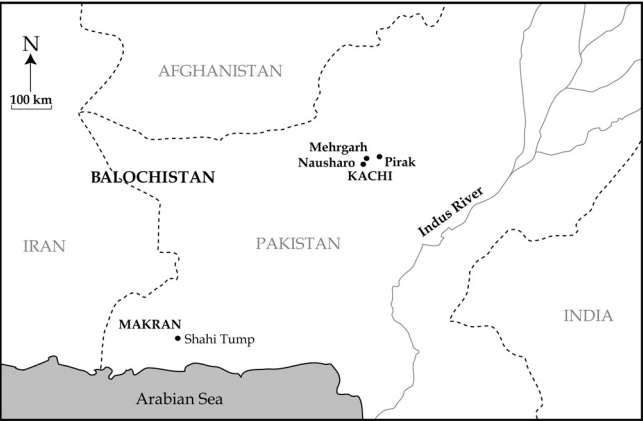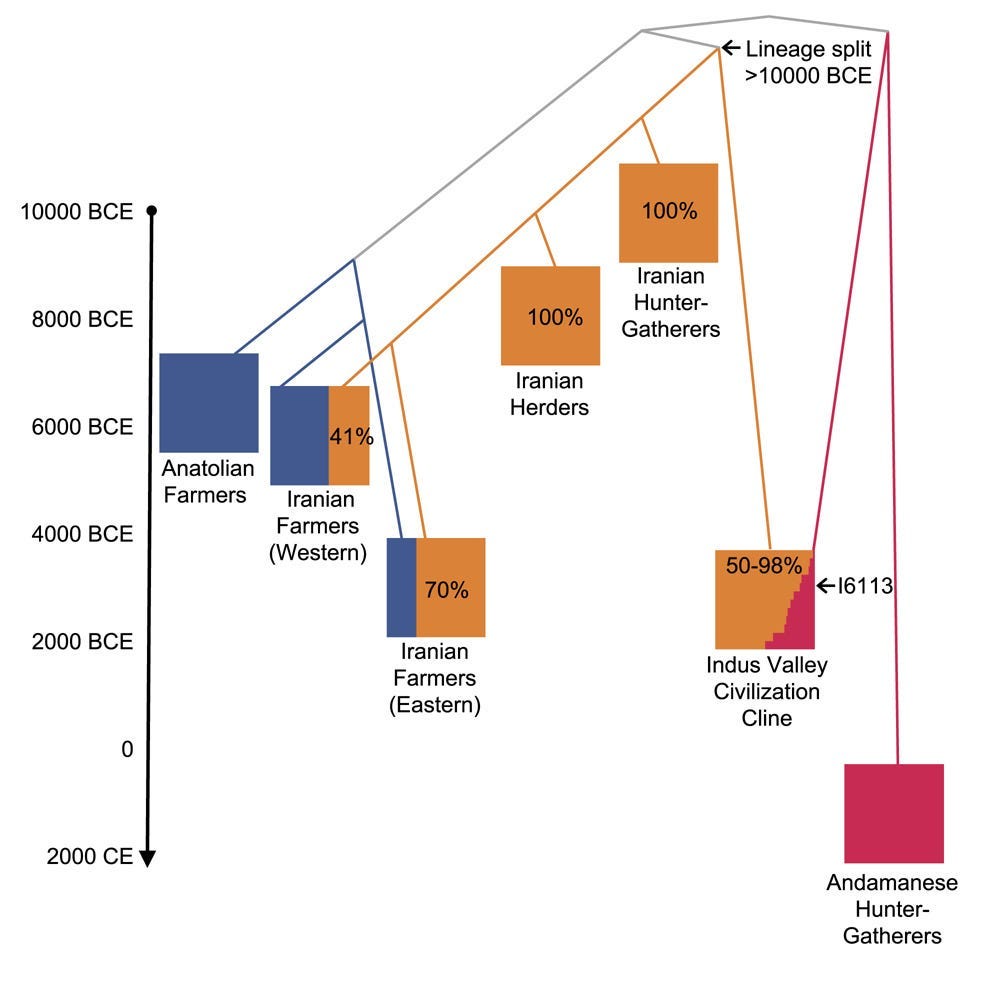The World's First Cotton Farmers
Mehrgarh and the Dawn of Civilization in the Indian Subcontinent

Around 5500 BC, two individuals were buried in the Kachi Plain in the Balochistan province of present-day Pakistan. One was an adult male lying on his side with his legs flexed backward. At his feet was a child, one or two years old. A low mud-brick wall enclosed their burial chamber.
Thousands of years later, in the 1990s, archaeologists from the French Archaeological Mission in Pakistan uncovered this grave. Located adjacent to the adult’s left wrist was an unusual artifact. Eight copper beads, formerly part of a bracelet, lay alongside his hand. This was one of just two regional burials that contained a copper relic.
A team from the Centre de Recherche et de Restauration des musées de France (C2RMF), led by anthropologist Christophe Moulherat, who specializes in studying ancient textiles, examined the beads in greater detail. When they split one of the beads, they were surprised to find vegetable fibers.
Further research confirmed that the fibers were cotton.
This is the world’s earliest known use of cotton. The remarkable people who made the copper bracelet belonged to the settlement of Mehrgarh, where farming originated in the Indian subcontinent.
Mehrgarh’s people established a vibrant culture that laid the groundwork for the Indus Valley Civilization, one of history’s most important Bronze Age civilizations.
Who were these enigmatic farmers of Mehrgarh, and where did they come from? How did they start cultivating cotton?
Let’s turn the clock back to 7000 BC and find out.
Reminder: By choosing a paid membership (just $5 a month or $50 annually), you're helping amplify voices that history books too often overlook. Your support means these stories get the attention they deserve.
You’ll gain access to tons of members-only content👇
Full-length deep dives into untold stories: no paywalls, no cuts.
The entire archive of amazing stories from the Ice Age to the Fall of the Mongol Empire, the hottest archaeological finds, and the appetizing history of food.
Early access to special editions—be the first to dive in.
Join lively discussions in members-only posts and subscriber chats.
Who were Mehrgarh’s Farmers?

Bolan Pass, located south of the Hindu Kush mountains, marks the boundary between the Indian and the Iranian plates. Lying in the northern part of the Kachi Plain, Mehrgarh is nestled in the foothills of the Bolan Pass.
Strategically situated between the fertile Indus basin to the east and the hilly Iranian plateau to the west, the Kachi Plain is a transition zone. The dry area experiences intense summers, often recording the highest temperatures in the Indian subcontinent.
But there’s a lifeline.
The Bolan River runs through this arid land, making its banks ideal for farming. Around 7000 BC, Mehrgarh emerged on the riverside as a small farming community of more than a hundred inhabitants.
Two theories exist about the origins of Mehrgarh’s farmers.
According to the first hypothesis, Anatolian farmers introduced agriculture to South Asia.
Before Mehrgarh, there was no indication that people were cultivating wild plants or herding wild animals. The Indian subcontinent’s indigenous hunter-gatherers lived on the Kachi Plain. We know this from the relics of microliths (tiny stone tools and weaponry like flint spears, arrows, etc) dating back before 7000 BC. This contrasts with the situation in the Near East, where humans gradually moved from hunter-gatherers to living in semi-sedentary communities before settling down to farm. Thus, given the abrupt transition from a nomadic to a settled way of life, agriculture must have been brought to Mehrgarh by migrant farmers from the Near East.
Other arguments support the introduction of farming from the Near East to the Indian subcontinent.
The wheat varieties found in Mehrgarh originated in the Near East. Mehrgarh’s circular fire pits filled with pebbles and granaries mirror their Mesopotamian counterparts from the same era. The positions of skeletal remains in Mehrgarh are similar to those at the Ali Kosh archeological site in Southern Iran’s Zagros Mountains.
Based on these arguments, can we conclude that the early farmers in Mehrgarh must have been migrants from the Near East, just as Anatolian farmers introduced agriculture to Europe?
Not quite.
Archaeologist Steven Mitthen believes it is difficult to explain human migrations from the Near East to South Asia since they require crossing the vast Iranian plateau before reaching the Bolan Pass’ foothills. The journey to Europe was shorter and less challenging.
But if humans can go to Australia, the Arctic, and the Americas, why can’t they reach the Indian subcontinent?
The Anatolian origins of Mehrgarh’s farmers appear plausible, but genetic studies and archeological finds have cast doubt on this.

Several researchers think that Mehrgarh’s agriculture and animal domestication have indigenous origins.
Jean-François Jarrige, the archaeologist who discovered the site in 1974, analyzed the animal bones unearthed there. He determined that cattle and sheep skeletal bones grew smaller over time, indicating a local domestication process. Had Anatolian farmers brought livestock, their bone sizes would have remained unchanged.
A dental analysis of the Mehrgarh people revealed their teeth were identical to those of South Asia’s indigenous hunter-gatherers. Neolithic farmers in the Near East developed tooth cavities because of a poor diet of coarsely ground cereals rich in carbohydrates. Surprisingly, cavities were absent among Mehrgarh’s farmers. Their teeth were bigger and healthier than their Near Eastern counterparts.
Recent genetic studies examined the DNA of Neolithic (7200 BC to 2500 BC) and Chalcolithic (4500 BC to 1000 BC) populations in Iran and South Asia. The researchers discovered that while Neolithic Iranian farmers had Anatolian farmer DNA, South Asian farmers lacked this component. After 6000 BC, there was very little gene flow from the Iranian plateau into the Indian subcontinent. This suggests that farming was a local development in the Indian subcontinent.
So, which theory about the origins of Mehrgarh’s farmers is correct?
Keep reading with a 7-day free trial
Subscribe to Forgotten Footprints to keep reading this post and get 7 days of free access to the full post archives.

